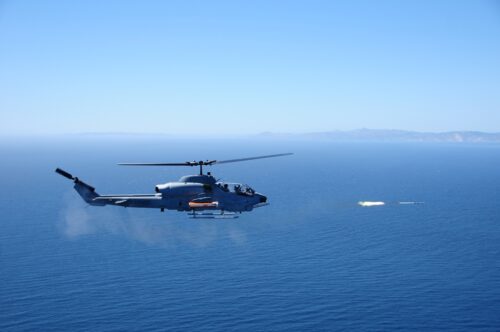LIG Nex 1, a South Korean defense contractor, is ramping up efforts to secure a historic arms deal with the United States. The company aims to finalize an export contract for its Bigung 2.75-inch (70mm) infrared-guided anti-ship missile system.

Photo: U.S. Navy
This potential deal would mark a significant milestone, as it would represent the first time a complete South Korean weapon system is integrated into the U.S. Navy’s arsenal. LIG Nex 1 is actively pursuing the contract. Koo Bon-sang, leader of the LIG Group, is scheduled to visit the U.S. for negotiations. This follows a series of successful evaluations by the Pentagon.
LIG Nex 1 has participated in four Foreign Comparative Testing (FCT) exercises of Bigung, led by the US government since 2023. With two more FCTs scheduled for 2024, successful completion of these rigorous evaluations is crucial for Bigung’s approval. If Bigung meets the U.S. Navy’s demanding standards, LIG Nex 1 anticipates progressing to final contract negotiations with the Pentagon.
The history of the Bigung can be traced back to the United States. In 1999, a critical need arose: a weapon capable of effectively engaging small, fast-moving maritime targets. This birthed the LOGIR (Low-Cost Guided Imaging Rocket) program. Backed by various U.S. agencies such as DARPA and Office of Naval Research, LOGIR successfully demonstrated the concept of a 2.75-inch rocket equipped with a revolutionary “fire-and-forget” infrared guidance system mounted ahead of the M151 high explosive warhead. This technology allowed the operator to launch the weapon and rely solely on its homing system to acquire and strike the target, eliminating the need for continuous guidance.
LOGIR’s success story progressed beyond its initial concept. A pivotal moment arrived in May 2010 when the Naval Air Systems Command (NAVAIR) conducted a successful third test launch at the Naval Air Warfare Center Weapons Division (NAWCWD) Point Mugu sea range. This critical test involved an AH-1W attack helicopter, a mainstay of the U.S. Marine Corps inventory at the time. Equipped with a LOGIR Fire Control System and LOGIR Smart Launcher, the helicopter launched the guided 2.75-inch rocket against a moving Fast Inshore Attack Craft (FIAC) target. Prior to firing, the target’s position and velocity data were transferred to the weapon from the launcher. Following launch, the rocket’s on-board guidance system took over, navigating to the target area, acquiring the moving Fast Inshore Attack Craft (FIAC) target, and ultimately scoring a direct hit.
With the successful third test firing, the program’s trajectory shifted from a solely U.S. endeavor to a collaborative effort with South Korea under the Medusa Joint Capability Technology Demonstration. This partnership proved immensely beneficial, allowing Korea to refine the design. The focus was two-fold:
- Enhancing Aerodynamics: Improvements were made to the rocket’s design to achieve better flight performance.
- Cost Reduction: The collaborative effort aimed to develop a more economical design for the overall system.
These advancements laid the foundation for Bigung, South Korea’s land-based adaptation of LOGIR. Bigung boasts a 2×18-round launchers carrying a total of 36 rockets, mounted on a highly mobile 6×6 truck. This system serves as a crucial element of the ROK Marine Corps’ coastal defense strategy. It is specifically designed to counter threats like North Korean Fast Inshore Attack Craft (FIACs), landing crafts, and landing vehicles.
Recent conflicts have highlighted the vulnerability of larger warships to agile, low-cost attack craft.
- Black Sea: During the ongoing conflict in Ukraine, small Ukrainian unmanned boats equipped with explosives have targeted Russian warships, demonstrating the potential for significant damage even from seemingly insignificant vessels.
- Red Sea: Houthi rebels in Yemen have employed similar tactics in the Red Sea, posing a threat to Western naval vessels operating in the region.
These incidents showcase the growing threat posed by small, fast attack craft. Their low cost and maneuverability make them difficult to defend against using traditional methods.
The LOGIR program, through its transformation into land-based systems like South Korea’s Bigung, offers a potential solution to this evolving threat.
- Rapid Response: Bigung’s mobility allows for swift deployment to counter fast-attacking vessels, providing a crucial advantage in close-quarters coastal engagements.
- Precision Targeting: The “fire-and-forget” guidance system of LOGIR rockets ensures accurate targeting, even against fast-moving targets.
- Cost-Effective Defense: Compared to traditional anti-ship missiles, LOGIR presents a more economical solution for deterring and eliminating threats posed by small attack craft, each round costs approximately $30,000.
While larger warships possess superior firepower, LOGIR systems like Bigung offer a crucial layer of defense specifically designed to counter the growing threat of agile, low-cost attackers. Their mobility, precision targeting, and cost-effectiveness make them a valuable asset in safeguarding naval vessels and deterring potential conflicts by creating a zone of denial for small, fast attack craft in coastal waters.
For more information, hit the Source below